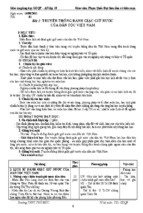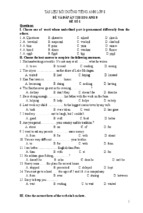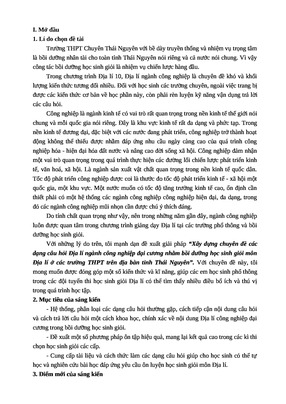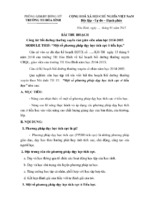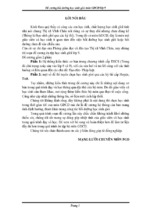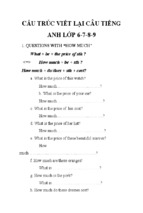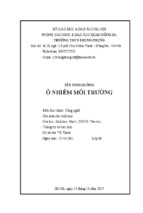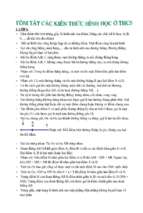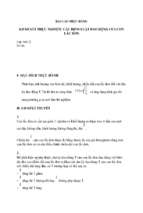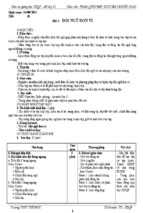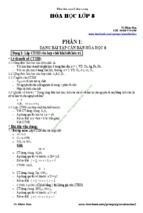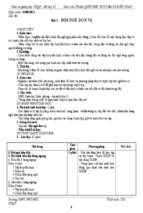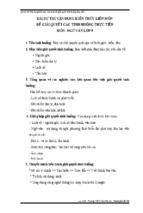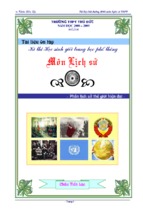Đọc hiểu
The three phases of human memory are the sensory memory, the short-term memory, and
the long- term memory. This devision of the memory into phases is based on the length of time
of the memory.
Sensory memory is instantaneous memory. It is an image or memory that enters your mind
only for a short period of time; it comes and goes in under a second. The memory will not last
longer than that unless the information enters the short-term memory.
Information can be held in the short-term memory for about twenty seconds or as long as
you are actively using it. If you repeat a fact to yourself, that fact will stay in your short-term
memory as long as you keeprepeating it. Once you stop repeating it, either it is forgotten or it
moves into long term memory.
Long-term memory is the huge memory tank that can hold ideas and images for years and
years. Information can be added to your long-term memory when you actively try to put it there
through memorization or when an idea or image enters your mind on its own.
Question 1: The best title for this pasage would be ______________
A. The difference between sensory and short-term memory.
B. How long it takes to memorize.
C. The stages of human memory.
D. Human phases.
Question 2: The three phases of memory discussed in the pasage are differentiated according to
______________
A. The location in the brain
B. The period of time it takes to remember something
C. How the senses are involved in the memory.
D. How long the memory lasts.
Question 3: The expression “is based on” in the first paragraph could be best replaced
by______________
A. Is on the top of
B. is at the foot of
C. depends on
D. is below
Question 4: According to the passage, which type of memory is the shortest?
A. Sensory memory
B. Active memory
C. Short-term memory D. Long-term memory
Question 5: According to the passage, when will information stay in your short-term memory?
A. For as long as twenty minutes
B. As long as it is being used.
C. After you have repeated it many times.
D. When it has moved into long-term memory.
Question 6: All of the following are TRUE about long – term memory EXCEPT
that______________
A. it has a very large capacity.
B. it can hold information.
C. it is possible to put information into it through memorization.
D. memorization is the only way that information can get there.
Question 7: he expression “on its own” in the last sentence can be best replaced by
“______________”
A. by itself
B. in it own time
C. with its possessions D. in only one way
Question 8: It can be inferred from the passage that if a person remembers a piece of
information for two days, this is probably ______________
A. three phases of memeory
B. the sensory memory
C. the short-term memory
D. the long-term memory
Telecommuting is some form of computer communication between employees’ homes
and offices. For employees whose job involve sitting at a terminal or word processor entering
data or typing reports, the location of the computer is of no consequence. If the machine can
communicate over telephone lines, when the work is completed, employees can dial the office
computer and transmit the material to their employers. A recent survey in USA Today estimates
that there are approximately 8,7 million telecommuters. But although the numbers are rising
annually, the trend does not appear to be as significant as predicted when Business Week
published “The Portable Executive” as its cover story a few years ago. Why hasn’t
telecommuting become more popular?
Clearly, change simply takes time. But in addition, there has been active resistance on the part of
many managers. These executives claim that supervising the telecommuters in a large work force
scattered across the country would be too difficult, or, at least, systems for managing them are
not yet developed, thereby complicating the manager’s responsibilities.
It is also true that employees who are given the option of telecommuting are reluctant to accept
the opportunity. Most people feel that they need regular interaction with a group, and many are
concerned that they will not have the same consideration for advancement if they are not more
visible in the office setting. Some people feel that even when a space in their homes is set aside
as a work area, they never really get away from the office.
Question 9: With which of the following topics is the passage primarily concerned?
A. An overview of telecommuting.
B. The failure of telecommuting.
C. The advantages of telecommuting.
D. A definition of telecommuting.
Question 10: How many Americans are involved in telecommuting?
A. More than predicted in Business Week.
B. More than 8 million.
C. Fewer than last year.
D. Fewer than estimated in USA Today.
Question 11: The phrase “of no consequence” means___________
A. of no use
B. irrelevant
C. of no good
D. unimportant
Question 12: The author mentions all of the following as concerns of telecommuting, EXCEPT
___________
A. the opportunities for advancement.
B. the different system of supervision.
C. the lack of interaction with a group.
D. The work place is in the home.
Question 13: The word “them” in the second paragraph refers to
A. telecommuters
B. systems
C.executives
D. responsibilities
Question 14: The reason why telecommuting has not become popular is that the employees
A. need regular interaction with their families.
B. are worried about the promotion if they are not seen at the office.
C. feel that a work area in their home is away from the office.
D. are ignorant of telecommuting.
Question 15: The word “reluctant” in the third paragraph can best be replaced by
A. opposite
B. willing
C. hesitant
D. typical
FAMILY LIFE IN THE UNITED STATES
Family life in the United States is changing. Fifty or sixty years ago, the wife was called a
“housewife”. She cleaned, cooked, and cared for the children. The husband earned the money for
the family. He was usually out working all day. He came home tired in the evening, so he did not
do much housework. And he did not see the children very much, except on weekends.
These days, however, more and more women work outside the home. They cannot stay
with the children all day. They, too, come home tired in the evening. They do not want to spend
the evening cooking dinner and cleaning up. They do not have time to clean the house and do the
laundry. So who is going to do the housework now? Who is going to take care of the children?
Many families solve the problem of housework by sharing it. In these families, the husband
and wife agree to do different jobs around the house, or they take turns doing each job. For
example, the husband always cooks dinner and the wife always does the laundry. Or the wife
cooks dinner on some nights and the husband cooks dinner on other nights.
Then there is the question of the children. In the past, many families got help with child
care from grandparents. Now families usually do not live near their relatives. The grandparents
are often too far away to help in a regular way. More often, parents have to pay for child care
help. The help may be a babysitter or a day-care center. The problem with t his kind of help is
the high cost. It is possible only for couples with jobs that pay well.
Parents may get another kind of help form the companies they work for. Many companies
now let people with children work part-time. That way, parents can spend mo re time with their
children. Some husbands may even stop working for a while to stay with the children. For these
men there is a new word: they are called “househusbands”. In the USA more and more men are
becoming househusbands every year.
These changes in the home mean changes in the family. Fathers can learn to understand
their children better, and the children can get to know their fathers better. Husbands and wives
may also find changes in their marriage. They, too, may have a better understanding of each
other.
Question 16: Sixty years ago, most women ____________
A. went out to work
B. had no children
C. did not do much housework
D. were housewives
Question 17: Nowadays, there are __________.
A. more women going out to work than before
B. more and more women staying with the children all day
C. more work outside the home than before
D. more housewives than before
Question 18: The word “laundry” in paragraph 2 is closest in meaning to ___________
A. tidying up
B. cooking and washing up
C. washing and ironing
D. shopping
Question 19: It can be inferred from paragraph 4 that__________.
A. couples with low-paid jobs can’t afford the cost of a babysitter or a day-care center
B. grandparents can help care the children in a regular way
C. all couples with jobs can pay for help from a babysitter or a day-care center
D. in the past, grandparents did not help the couples with child care
Question 20: The word “they” in paragraph 5 refers to _______________
A. husbands who stop working to stay with the children
B. fathers who spend more time with their children
C. parents who work part-time
D. children who spend more time with fathers than mothers
Question 21: The changes in the American home mentioned in this passage may _________
A. help families
B. not happen
C. cause problems for a marriage
D. not change the children at all
Question 22: This article is about ________
A. American men as househusbands
B. housewives in America
C. how more American women are working D. how family life in America is changing
.
Because writing has become so important in our culture, we sometimes think of it as more real
than speech. A little thought, however, will show w hy speech is primary and writing secondary
to language. Human beings have been writing (as far as we can tell from surviving evidence) for
at least 5000 years; but they have been talking for much longer, doubtless ever since there have
been human beings.
When writing did develop, it was derived from and represented speech, although imperfectly.
Even today there are spoken languages that have no written form. Furthermore, we all learn to
talk well before we learn to write; any human child who is not severely handicapped physically
or mentally will learn to talk: a normal human being cannot be prevented from doing so. On the
other hand, it takes a special effort to learn to write. In the past many intelligent and useful
members of society did not acquire the skill, and even today many who speak languages with
writing systems never learn to read or write, while some who learn the rudiments of those skills
do so only imperfectly.
To affirm the primacy of speech over writing is not, however, to disparage the latter. One
advantage writing has over speech is that it is more permanent and makes possible the records
that any civilization must have. Thus, if speaking makes us human, writing makes us civilized.
Question 23: We sometimes think of writing as more real than speech because ______.
A. writing is secondary to language
B. human beings have been writing for at least 5000 years
C. it has become very important in our culture
D. people have been writing since there have been human beings
Question 24: The author of the passage argues that ______.
A. speech is more basic to language than writing
B. writing has become too important in today’s society
C. everyone who learns to speak must learn to write
D. all languages should have a written form
Question 25: According to the passage, writing ______.
A. is represented perfectly by speech
B. represents speech, but not perfectly
C. developed from imperfect speech
D. is imperfect, but less so than speech
Question 26: Normal human beings ______.
A. learn to talk after learning to write
B. learn t o write before learning to talk
C. learn to write and to talk at the same time D. learn to talk before learning to write
Question 27: Learning to write is ______.
A. easy
B. too difficult
C. not easy
D. very easy
Question 28: In order to show that learning to write requires effort, the author gives the example
of _________.
A. people who learn the rudiments of speech B. severely handicapped children
C. intelligent people who couldn’t write
D. people who speak many languages
Question 29: In the author’s judgment, ______.
A. writing has more advantages than speech
B. writing is more real than speech
C. speech conveys ideas less accurately than writing does
D. speech is essential but writing has important benefits
Question 30: The word “advantage” in the last paragraph most closely means ______.
A. “rudiments”
B. “skill”
C. “domination”
D. “benefit”
It used to be that people would drink coffee or tea in the morning to pick them up and get
them going for the day. Then cola drinks hit the market. With lots of caffeine and sugar, these
beverages soon became the pick-me-up of choice for many adults and teenagers. Now drink
companies are putting out so-called "energy drinks." These beverages have the specific aim of
giving tired consumers more energy.
One example of a popular energy drink is Red Bull. The company that puts out this
beverage has stated in interviews that Red Bull is not a thirst quencher. Nor is it meant to be a
fluid replacement drink for athletes. Instead, the beverage is meant to revitalize a tired
consumer’s body and mind. In order to do this, the makers of Red Bull, and other energy drinks,
typically add vitamins and certain chemicals to their beverages. The added chemicals are like
chemicals that the body naturally produces for energy. The vitamins, chemicals, caffeine, and
sugar found in these beverages all seem like a sure bet to give a person energy.
Health professionals are not so sure, though. For one thing, there is not enough evidence to
show that all of the vitamins added to energy drinks actually raise a person’s energy level.
Another problem is that there are so many things in the beverages. Nobody knows for sure how
all of the ingredients in energy drinks work together.
Dr. Brent Bauer, one of the directors at the Mayo Clinic in the US, cautions people about
believing all the claims energy drinks make. He says, - It is plausible if you put all these things
together, you will get a good result.” However, Dr. Bauer adds the mix of ingredients could also
have a negative impact on the body. - We just don’t know at this point,” he says.
(Source: -Reading Challenge 2, Casey Malarcher & Andrea Janzen, Compass Publishing)
Question 31: The beverages mentioned in the first paragraph aim to give consumers ______.
A. caffeine
B. sugar
C. more energy
D. more choices
Question 32: The word “it” in the second paragraph refers to ______.
A. one example
B. the company
C. Red Bull
D. thirst quencher
Question 33: According to the passage, what makes it difficult for researchers to know if an
energy drink gives people energy?
A. Natural chemicals in a person’s body
B. The average age of the consumer
C. The number of beverage makers
D. The mixture of various ingredients
Question 34: The word -plausible‖ in the passage is closest in meaning to _______.
A. impossible
B. reasonable
C. typical
D. unlikely
Question 35: What has Dr. Bauer probably researched?
A. Countries where Red Bull is popular
B. Energy drinks for teenage athletes
C. Habits of healthy and unhealthy adults
D. Vitamins and chemicals in the body
Question 36: Which of the following is NOT true according to the passage?
A. Bauer does not seem to believe the claims of energy drink makers.
B. Colas have been on the market longer than energy drinks.
C. It has been scientifically proved that energy drinks work.
D. The makers of Red Bull say that it can revitalize a person.
Question 37: What is the main idea of this passage?
A. Caffeine is bad for people to drink.
B. It is uncertain whether energy drinks are healthy.
C. Red Bull is the best energy drink.
D. Teenagers should not choose energy drinks.
What is “extreme” weather? Why are people talking about it these days? “Extreme”
weather is an unusual weather event such as rainfall, a drought or a heat wave in the wrong place
or at the wrong time. In theory, they are very rare. But these days, our TV screens are constantly
showing such extreme weather events. Take just three news stories from 2010: 28 centimetres of
rain fell on Rio de Janeiro in 24 hours, Nashville, USA, had 33 centimetres of rain in two days
and there was record rainfall in Pakistan.
The effects of this kind of rainfall are dramatic and lethal. In Rio de Janeiro, landslides
followed, burying hundreds of people. In Pakistan, the floods affected 20 million people.
Meanwhile, other parts of the world suffer devastating droughts. Australia, Russia and East
Africa have been hit in the last ten years. And then there are unexpected heat waves, such as in
2003 in Europe. That summer, 35,000 deaths were said to be heat-related.
So, what is happening to our weather? Are these extreme events part of a natural cycle? Or
are they caused by human activity and its effects on the Earth’s climate? Peter Miller says it’s
probably a mixture of both of these things. On the one hand, the most important influences on
weather events are natural cycles in the climate. Two of the most famous weather cycles, El Niño
and La Niña, originate in the Pacific Ocean. The heat from the warm ocean rises high into the
atmosphere and affects weather all around the world. On the other hand, the temperature of the
Earth’s oceans is slowly but steadily going up. And this is a result of human activity. We are
producing greenhouse gases that trap heat in the Earth’s atmosphere. This heat warms up the
atmosphere, land and oceans. Warmer oceans produce more water vapour – think of heating a
pan of water in your kitchen. Turn up the heat, it produces steam more quickly. Satellite data
tells us that the water vapour in the atmosphere has gone up by four percent in 25 years. This
warm, wet air turns into the rain, storms, hurricanes and typhoons that we are increasingly
experiencing. Climate scientist, Michael Oppenheimer, says that we need to face the reality of
climate change. And we also need to act now to save lives and money in the future.
(Source: © 2015 National Geographic Learning.www.ngllife.com/wildweather)
Question 38: It is stated in the passage that extreme weather is ______.
A. becoming more common
B. not a natural occurrence
C. difficult for scientists to understand
D. killing more people than ever before
Question 39: The word -lethal‖ in the second paragraph probably means ______.
A. far-reaching
B. long-lasting
C. happening soon
D. causing deaths
Question 40: What caused thousands of deaths in 2003?
A. a period of hot weather
B. floods after a bad summer
C. a long spell of heavy rain
D. large-scale landslides
Question 41: According to the passage, extreme weather is a problem because ______.
A. we can never predict it
B. it only affects crowded places
C. it’s often very destructive
D. its causes are completely unknown
Question 42: The word -that in the third paragraph refers to ______.
A. Earth’s oceans
B. human activity
C. greenhouse gases
D. Earth’s atmosphere
Question 43: Extreme weather can be caused by ______.
A. satellites above the Earth
B. water vapour in the atmosphere
C. very hot summers
D. water pans in your kitchen
Question 44: Satellites are used to ______.
A. change the direction of severe storms
B. trap greenhouse gases in the atmosphere
C. measure changes in atmospheric water vapour
D. prevent climate from changing quickly Question
Question 45: Which statement is NOT supported by the information in the passage?
A. Extreme weather is substantially influenced by human activity.
B. Unusual weather events are part of natural cycles.
C. We can limit the bad effects of extreme weather.
D. Such extreme weather is hardly the consequence of human activity.
A number of factors related to the voice reveal the personality of the speaker.
The first is the broad area of communication, which includes imparting information by use
of language, communicating with a group or an individual and specialized communication
through performance. A person conveys thoughts and ideas through choice of words, by a tone
of voice that is pleasant or unpleasant, gentle or harsh, by the rhythm that is inherent within the
language itself, and by speech rhythms that are flowing and regular or uneven and hesitant, and
finally, by the pitch and melody of the utterance. When speaking before a group, a person's tone
may indicate uncertainty or fright, confidence or calm. At interpersonal levels, the tone may
reflect ideas and feelings over and above the words chosen, or may belie them.
Here the participant’s tone can consciously or unconsciously reflect intuitive sympathy or
antipathy, lack of concern or interest, fatigue, anxiety, enthusiasm or excitement, all of which
are .usually discernible by the acute listener. Public performance is a manner of communication
that is highly specialized with its own techniques for obtaining effects by voice and /or gesture.
The motivation derived from the text, and in the case of singing, the music, in combination with
the performer's skills, personality, and ability to create empathy will determine the success of
artistic, political, or pedagogic communication.
Second, the voice gives psychological clues to a person's self-image, perception of others,
and emotional health. Self-image can be indicated by a tone of voice that is confident,
pretentious, shy, aggressive, outgoing, or exuberant, to name only a few personality traits. Also
the sound may give a clue to the facade or mask of that person, for example, a shy person hiding
behind an overconfident front. How a speaker perceives the listener's receptiveness, interest, or
sympathy in any given conversation can drastically alter the tone of presentation, by
encouraging or discouraging the speaker. Emotional health is evidenced in the voice by free and
melodic sounds of the happy, by constricted and harsh sound of the angry, and by dull and
lethargic qualities of the depressed.
Question 46: What does the passage mainly discuss?
A. The function of the voice in performance
B. Communication styles
C. The connection between voice and personality
D. The production of speech
Question 47: What does the author mean by staring that, "At interpersonal levels, tone may
reflect ideas and feelings over and above the words chosen" ?
A. Feelings are expressed with different words than ideas are.
B. The tone of voice can carry information beyond the meaning of words.
C. A high tone of voice reflects an emotional communication.
D. Feelings are more difficult to express than ideas.
Question 48: The word "Here" in line 9 refers to……………
A. At interpersonal levels
B. the tone
C. ideas and feelings
D. words chosen
Question 49: Why does the author mention "artistic, political, or pedagogic communication" ?
A. As examples of public performance
B. As examples of basic styles of communication
C. To contrast them to singing
D. To introduce the idea of self-image
Question 50: According to the passage, an exuberant tone of voice may be an indication of a
person's___________
A. general physical health
B. personality
C. registered
D. obtained
Question 51: According to the passage, an overconfident front may hide___________.
A. hostility
B. shyness
C. friendliness
D. strength
Question 52: The word "drastically" in line 21 is closest in meaning to___________.
A. frequently
B. exactly
C. severely
D. easily
Question 53: According to the passage, what does a constricted and harsh voice indicate?
A. Lethargy
B. Depression
C. Boredom
D. Anger
The rules of etiquette in American restaurants depend upon a number of factors the
physical location of the restaurant, e.g., rural or urban; the type of restaurant, e.g., informal or
formal; and certain standards that are more universal. In other words, some standards 5 of
etiquette vary significantly while other standards apply almost anywhere. Learning the proper
etiquette in a particular type of restaurant in a particular area may sometimes require instruction,
but more commonly it simply requires sensitivity and experience. For example, while it is
acceptable to read a magazine in a coffee shop, it is 10 inappropriate to do the same in a more
luxurious setting. And, if you are eating in a very rustic setting it may be fine to tuck your napkin
into your shirt, but if you are in a sophisticated urban restaurant this behavior would
demonstrate a lack of manners. It is safe to say, however, that in virtually every restaurant it is
unacceptable 15 to indiscriminately throw your food on the floor. The conclusion we can most
likely draw from the above is that while the types and locations of restaurants determine etiquette
appropriate to them, some rules apply to all restaurants.
Question 54: What topic is this passage primarily concerned?
A. instruction in proper etiquette
B. rules of etiquette
C. variable and universal standards of etiquette
D. the importance of good manners
Question 55: According to the passage,which of the following is a universal rule of etiquette?
A. reading a magazine at a coffee shop
B. not throwing food on the floor
C. eating in rustic settings
D. tucking a napkin in your shirt
Question 56: According to the passage,
requires sensitivity and experience?
A. reading a magazine at a coffee shop
B. not throwing food on the floor
C. eating in rustic settings
D. tucking a napkin in your shirt
Question 57: Which of the following words is most similar to the meaning of “rustic” ?
A. urban
B. unsophisticated
C. agricultural
D. ancient
Question 58: Which of the following is closest in meaning to the word “tuck” in line 11?
A. set
B. put
C. fold
D. hold
Question 59: The word “sophisticated” in line 12 could best be replaced by?
A. famous
B. cultured
C. expensive
D. exclusive
Question 60: What is the author’s main purpose in this passage?
A. to compare sophisticated and rustic restaurants
B. to assist people in learning sophisticatedmanners
C. to simplify rules of restaurant etiquette
D. to describe variations in restaurant manners
Who talks more – men or women? Most people believe that women talk more. However,
linguist Deborah Tannen, who has the studied the communication style of men and women, says
that this is a stereotype. According to Tannen, women are more verbal – talk more – in private
situations, where they use conversation as the “glue” to hold relationship together. But, she says,
men talk more in public situations, where they use conversation to exchange information and
gain status. Tannen points out that we can see these difference even in children. Little girls often
play with one ‘best friend’ and their play includes a lot of conversation. Little boys often play
games in groups, their play usually involves more doing than talking. In school, girls are often
better at verbal skills, while boys are often better at mathematics.
A recent study at Emory University helps to shed light on the roots of this difference.
Researchers studied conversation between children aged 3-6 and their parents. They found
evidence that parents talk very differently to their sons than they do to their daughters. The
startling conclusion was that parents use more language with their girls. Specifically, when
parents talk with their daughters, they use more descriptive language and more details. There is
also far more talk about emotions, especially with daughters than with sons.
Question 61: Which sentence best expresses the main idea of the first paragraph?
A. Women talk more than men on the whole
B. Women’s talking is a stereotype
C. Women talk more in private, and men talk more in public
D. Little boys and little girls have different ways of playing
Question 62: Which word is similar in meaning to the word “glue”?
A. Games
B. sticky substance
C. rope
D. means
Question 63: Which of the following phrases best explains the meaning of the word “verbal”?
A. Deriving from verbs
B. Connected with use of spoken language
C. Using very loud noise
D. Being very talkative
Question 64: The word “they” refers to ______.
A. Situations
B. Men
C. Men and women
D. Women
Question 65: Which of the following can be inferred from the first paragraph?
A. Men and women have different styles of talking, which may begin in childhood.
B. According to Deborah Tannen, the belief that women talk more is party right but most
wrong.
C. Women talk more in some situations while men talk in others
D. Men are more sociable than women
Question 66: Which sentence best expresses the main idea of the second paragraph?
A. Researchers have studied the conversations of children and their parents.
B. Parents do not much about sadness with their sons.
C. Study at Emory University can help to explain the differences between communication
styles of boy and girls.
D. An Emory University study found than parent talk more with their daughters than with
their sons.
Question 67: Which word can best replace the word “startling”?
A. Beginning
B. annoying
C. surprising
D. interesting
Question 68: Which of the following statement is TRUE about the passage?
A. Parents give more love to their daughters than to their sons
B. Boys don’t like to be with their parents as much as girls do
C. Parents use more language to talk with their daughters
D. Boys don’t like showing emotions
Stars have been significant features in the design of many United States coins and their
number has varied from one to forty-eight stars. Most of the coins issued from about 1799 to the
early years of the twentieth century bore thirteen stars representing the thirteen original colonies.
Curiously enough, the first American silver coins, issued in 1794, had fifteen stars because
by that time Vermont and Kentucky has joined the Union. At that time it was apparently the
intention of mint officials to add a star for each new state. Following the admission of Tennessee
in 1796, for example, some varieties of half dimes, dimes, and half-dollars were produced with
sixteen starts.
As more states were admitted to the Union, however, it quickly became apparent that this
scheme would not prove practical and the coins from A798 on were issued with only thirteen
stars-one for each of the original colonies. Due to an error at the mint, one variety of the A828
half cent was issued with only twelve stars. There is also a variety of the large cent with only A2
stars, but this is the result of a die break and is not a true error.
Question 69: What is the main topic of the passage?
A. Stars on American coins
B. The teaching of astronomy in state universities
C. The star as national symbol of the United States
D. Colonial stamps and coins
Question 70: The word “their” in line 1 refers to _______
A. Coins
B. features
C. colonies
D. stars
Question 71: The word “bore” in line 3 is closest in meaning to ________
A. Carried
B. drilled
C. symbolized
D. cost
Question 72: The expression “Curiously enough” is used because the author finds it strange that
_______
A. Silver coins with fifteen stars appeared before coins with thirteen
B. Vermont and Kentucky joined the Union in 1794
C. Tennessee was the first state to use half dimes
D. No silver coins were issued until 1794
Question 73: Which of the following can be inferred about the order in which Kentucky,
Tennessee, and Vermont joined the Union?
A. Vermont joined after Tennessee and Kentucky.
B. Kentucky joined before Tennessee and Vermont.
C. Tennessee joined Vermont and Kentucky.
D. Vermont and Kentucky joined at the same time.
Question 74: Which of the following is NOT mentioned as the denomination of an American
coin?
A. Half cent
B. Half-dollar
C. Half dime
D. Half nickel
Question 75: Why was a coin produced in 1828 with only twelve stars?
A. There was a change in design policy.
B. There were twelve states at the time.
C. The mint made a mistake.
D. Tennessee had left the Union.
Harvard University, today recognized as part of the top echelon of the world's universities,
came from very inauspicious and humble beginning.
This oldest of American universities was founded in 1636, just sixteen years after the Pilgrims
landed at Plymouth. Included in the Puritan emigrants to the Massachusetts colony during this
period were more than 100 graduates of England's prestigious Oxford and Cambridge
universities, and these universities graduates in the New Word were determined that their sons
would have the same educational opportunities that they themselves had had. Because of this
support in the colony for an institution of higher learning, the General
Court of Massachusetts appropriated 400 pounds for a college in October of 1636 and early
the following year decided on a parcel of land for the school; this land was in an area called
Newetowne, which was later renamed Cambridge after its English cousin and is the site of the
present-day university.
When a young minister named John Harvard, who came from the neighboring town of
Charlestowne, died from tuberculosis in 1638, he willed half of his estate of 1,700 pounds to the
fledgling college. In spite of the fact that only half of the bequest was actually paid, the General
Court named the college after the minister in appreciation for what he had done. The amount of
the bequest may not have been large, particularly by today's standard, but it was more than the
General Court had found it necessary to appropriate in order to open the college.
Henry Dunster was appointed the first president of Harvard in 1640, and it should be noted
that in addition to serving as president, he was also the entire faculty, with an entering freshmen
class of four students. Although the staff did expand somewhat, for the first century of its
existence the entire teaching staff consisted of the president and three or four tutors.
Question 76: The main idea of this passage is that ______________ .
A. Harvard University developed under the auspices of the General Court of Massachusetts
B. What is today a great university started out small
C. John Harvard was key to the development of a great university
D. Harvard is one of the world's most prestigious universities.
Question 77: The passage indicates that Harvard is ______________.
A. one of the oldest universities in the world
B. the oldest university in the world
C. one of the oldest universities in America
D. the oldest university in America
Question 78: It can be inferred from the passage that the Puritans who traveled to the
Massachusetts colony were ______________.
A. rather rich
B. Rather well educated
C. rather supportive of the English government
D. rather undemocratic
Question 79: The pronoun "they" in the second paragraph refers to ______________.
A. son
B. university graduates
C. Oxford and Cambridge universities
D. educational opportunities
Question 80: The "pounds" in the second paragraph are probably ______________.
A. units of money
B. college students
C. types of books
D. school campuses
Question 81: Which of the following is NOT mentioned about John Harvard?
A. What he died of
B. Where he came from
C. Where he was buried
D. How much he bequeathed to Harvard
Question 82: The passage implies that ______________.
A. Someone else really served as president of Harvard before Henry Dunster
B. Henry Dunster was an ineffective president
C. Henry Dunster spent much of his time as president managing the Harvard faculty
D. The position of president of Harvard was not merely an administrative position in the early
ears
Question 83: The word "somewhat" in the last paragraph could best be replaced by
______________.
A. to and pro
B. Back and forth
C. side by side
D. more or less
In early civilization, citizens were educated informally, usually within the family unit.
Education meant simply learning to live. As civilization became more complex, however,
education became more formal, structured, and comprehensive. Initial efforts of the ancient
Chinese and Greek societies concentrated solely on the education of males. The post-Babylonian
Jews and Plato were exceptions to this pattern. Plato was apparently the first significant advocate
of the equality of the sexes. Women, in his ideal state, would have the same rights and duties and
the same educational opportunities as men. This aspect of Platonic philosophy, however, had
little or no effect on education for many centuries, and the concept of a liberal education for men
only, which had been espoused by Aristotle, prevailed.
In ancient Rome, the availability of an education was radually extended to women, but they
were taught separately from men. The early Christians and medieval Europeans continued this
trend, and single-sex schools for the privileged through classes prevailed through the
Reformation period. Gradually, however, education for women, in a separate but equal basis to
that provided for men, was becoming a clear responsibility of society. Martin Luther appealed
for civil support of schools for all children. Al the Council of Trent in the 16th century, the
Roman Catholic Church encouraged the establishment of free primary schools for children of all
classes. The concept of universal primary education, regardless of sex, had been born, but it was
still in the realm of the single-sex school.
In the late 19th and early 20th centuries, co-education became a more widely applied
principle of educational philosophy. In Britain, Germany, and the Soviet Union the education of
boys and girls in the same classes became an accepted practice. Since World War II, Japan and
the Scandinavian countries have also adopted relatively universal co-educational systems. The
greatest negative reaction to co-education has been felt in the teaching systems of the Latin
countries, where the sexes have usually been separated at both primary and secondary levels,
according to local conditions.
A number of studies have indicated that girls seem to perform better overall and in science
in particular. In single-sex classes, during the adolescent years, pressure to conform to
stereotypical female gender roles may disadvantage girls in traditionally male subjects, making
them reluctant to volunteer for experimental work while taking part in lessons. In Britain,
academic league tables point to high standards achieved in girls’ schools. Some educationalists,
therefore, suggest segregation of the sexes as a good thing, particularly in certain areas, and a
number of schools are experimenting with the idea.
Question 84: Ancient education generally focused its efforts on __________.
A. young people only B. on male learners
C. both sexes
D. female learners
Question 85: Education in early times was mostly aimed at __________.
A. teaching skills
B. learning new lifestyles
C. learning to live
D. imparting survival skills
Question 86: The first to support the equality of the sexes was __________.
A. the Chinese
B. the Jews
C. Plato
D. the Greek
Question 87: The word “informally” in this context mostly refers to an education occurring
__________.
A. in a department
B. in classrooms
C. ability
D. outside the school
Question 88: When education first reached women, they were __________.
A. separated from men
B. locked up in a place with men
C. deprived of opportunities
D. isolated from a normal life
Question 89: When the concept of universal primary education was introduced, education
__________.
A. was intended for all the sexes
B. was intended for all the sexes
C. was given free to all
D. focused on imparting skills
Question 90: Co-education was negatively responded to in __________.
A. conservative countries
C. South American countries
B. Japan
D. the Scandinavian countries
Animals have an intuitive awareness of quantities. They know without analysis the
difference between a number of objects and a smaller number. In his book “ The natural History
of Selboure ” (1786 ) , the naturalist Gilbert White tells how he surreptitiously removed one egg
a day from a plover’s nest , and how the mother laid another egg each day to make up for the
missing one . He noted that other species of birds ignore the absence of a single egg but abandon
their nests if more than one egg has been removed. It has also been noted by naturalists that a
certain type of wasp always provides five – never four, never six - caterpillars for each of their
eggs so that their young have something to eat when the eggs hatch . Research has also shown
that both mice and pigeons can be taught to distinguish between odd and even numbers of food
pieces.
These and similar accounts have led some people to infer that creatures other than
humans can actually count. They also point to dogs that have been taught to respond to
numerical questions with the correct number of barks, or to horses that seem to solve arithmetic
problems by stomping their hooves the proper number of times.
Animals respond to quantities only when they are connected to survival as a species – as
in the case of the eggs – or survival as individuals - as in the case of food. There is no transfer to
other situations or from concrete reality to the abstract notion of numbers. Animals can “count”
only when the objects are present and only when the numbers involved are small – not more than
seven or eight. In lab experiments, animals trained to “count” one kind of object were unable to
count any other type. The objects, not the numbers, are what interest them. Animals admittedly
remarkable achievements simply do not amount to evidence of counting, nor do they reveal
more than innate instincts, refined by the genes of successive generations, or the results of clever,
careful conditioning by trainers .
Question 91: What is the main idea of this passage?
A. Although animals may be aware of quantities, they cannot actually count.
B. Of all animals, dogs and horses can count best.
C. Careful training is required to teach animals to perform tricks involving numbers
D. Animals cannot “count” more than one kind of object.
Question 92: Why does the author refer to Gilbert White’s book in line 2?
A. To indicate that more research is needed in this field.
B. To show how attitudes have changed since1786.
C. To provide evidence that some birds are aware of quantities.
D. To contradict the idea that animals can count.
Question 93: The word “surreptitiously” is closest in meaning to
A. quickly
B. occasionally
C. stubbornly
D. secretly
Question 94: The word “odd” refers to which of the following?
A. numbers such as 1, 3, 5 and so on
B. lucky numbers
C. numbers such as 2, 4, 6 and so on
D. unusual numbers
Question 95: The author mentions that all of the following are aware of quantities in some ways
EXCEPT
A. wasps
B. Plovers
C. caterpillars
D. mice
Question 96: The word “accounts” is closest in meaning to
A. reasons
B. reports
C. deceptions
D. invoices
Question 97: How would the author probably characterize the people who are mentioned in
the first line of the second paragraph
A. As foolish
B. As demanding
C. As clever
D. As mistaken
Until recently, most American entrepreneurs were men. Discrimination against women in
business, the demands of caring for families, and lack of business training had kept the number
of women entrepreneurs small. Now, however, businesses owned by women account for more
than $40 billion in annual revenues, and this figure is likely to continue rising throughout the
1990s. As Carolyn Doppelt Gray, an official of the Small Business Administration, has noted,
"The 1970s was the decade of women entering management, and the 1980s turned out to be the
decade of the woman entrepreneur". What are some of the factors behind this trend? For one
thing, as more women earn advanced degrees in business and enter the corporate world, they are
finding obstacles. Women are still excluded from most executive suites. Charlotte Taylor, a
management consultant, had noted, "In the 1970s women believed if they got an MBA and
worked hard they could become chairman of the board. Now they've found out that isn't going to
happen, so they go out on their own".
In the past, most women entrepreneurs worked in "women's" fields: cosmetics and
clothing, for example. But this is changing. Consider ASK Computer Systems, a $22-million-ayear computer software business. It was founded in 1973 by Sandra Kurtzig, who was then a
housewife with degrees in math and engineering. When Kurtzig founded the business, her first
product was software that let weekly newspapers keep tabs on their newspaper carriers-and her
office was a bedroom at home, with a shoebox under the bed to hold the company's cash. After
she succeeded with the newspaper software system, she hired several bright computer-science
graduates to develop additional programs. When these were marketed and sold, ASK began to
grow. It now has 200 employees, and Sandra Kurtzig owns $66.9 million of stock.
Of course, many women who start their own businesses fail, just as men often do. They
still face hurdles in the business world, especially problems in raising money; the banking and
finance world is still dominated by men, and old attitudes die hard. Most businesses owned by
women are still quite small. But the situation is changing; there are likely to be many more
Sandra Kurtzigs in the years ahead.
Question 98: What is the main idea of this passage?
A. The computer is especially lucrative for women today.
B. Women today are better educated than in the past, making them more attractive to the business
world.
C. Women are better at small business than men are.
D. Women today are opening more business of their own.
Question 99: The word “excluded” is closest meaning to ___________ .
A. often invited to
B. decorators of
C. not permitted in
D. charged admission to
- Xem thêm -


